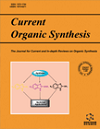
Full text loading...
We use cookies to track usage and preferences.I Understand
Condensation of 3-acetyl coumarin (1) with 2‐(4-methoxy- benzylidene)malononitrile (2) in ammonium acetate/acetic acid or absolute ethanol/piperidine affords pyridine (3) and chromen-2-one (4) derivatives, respectively.
In this study, the reaction of 3 with an electrophilic reagent, namely, formic acid, acetic anhydride and formamide afforded the pyridopyrimidinone and pyridine derivatives (6-9). Also, treatment of 3 with different aromatic aldehydes, carbon disulfide, NaN3/NH4Cl, 2-(4-methoxybenzylidene)malononitrile and acetophenone afforded pyridopyrimidinone, carbamodithioic acid, tetrazol-5-yl-chromen-2-one, 2H-chromen-2-one, and pyridine derivatives (10-14), respectively.
This study synthesized coumarins with antimicrobial activity and verified the structure and purity of the synthesized compounds using spectral data.
The new compounds were evaluated in vitro for their antimicrobial activity against gram-positive bacteria (Staphylococcus aureus, Methicillin-resistant Staphylococcus aureus) and gram-negative bacteria (Escherichia coli, Pseudomonas aeruginosa), in addition to fungus (Candida albicans). The investigated substances 3 and 14 presented good activity against MRSA, E. coli, P. aeruginosa and C. albicans, while compounds 9, 10a-c, 11, 12 and 13 exhibited good to moderate activity.

Article metrics loading...

Full text loading...
References


Data & Media loading...
Supplements

